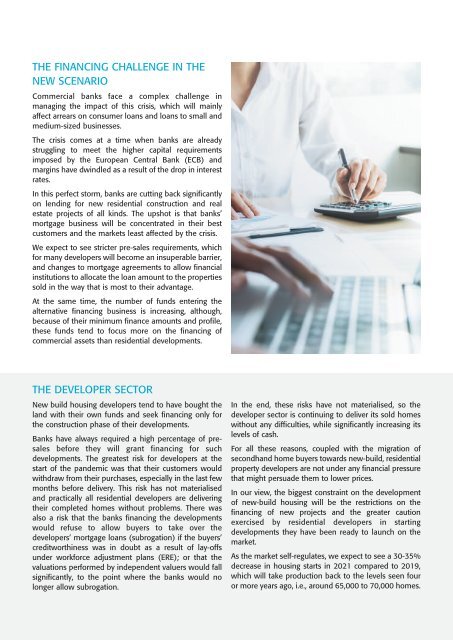Create successful ePaper yourself
Turn your PDF publications into a flip-book with our unique Google optimized e-Paper software.
THE FINANCING CHALLENGE IN THE<br />
NEW SCENARIO<br />
Commercial banks face a complex challenge in<br />
managing the impact of this crisis, which will mainly<br />
affect arrears on consumer loans and loans to small and<br />
medium-sized businesses.<br />
The crisis comes at a time when banks are already<br />
struggling to meet the higher capital requirements<br />
imposed by the European Central Bank (ECB) and<br />
margins have dwindled as a result of the drop in interest<br />
rates.<br />
In this perfect storm, banks are cutting back significantly<br />
on lending for new residential construction and real<br />
estate projects of all kinds. The upshot is that banks’<br />
mortgage business will be concentrated in their best<br />
customers and the markets least affected by the crisis.<br />
We expect to see stricter pre-sales requirements, which<br />
for many developers will become an insuperable barrier,<br />
and changes to mortgage agreements to allow financial<br />
institutions to allocate the loan amount to the properties<br />
sold in the way that is most to their advantage.<br />
At the same time, the number of funds entering the<br />
alternative financing business is increasing, although,<br />
because of their minimum finance amounts and profile,<br />
these funds tend to focus more on the financing of<br />
commercial assets than residential developments.<br />
THE DEVELOPER SECTOR<br />
New build housing developers tend to have bought the<br />
land with their own funds and seek financing only for<br />
the construction phase of their developments.<br />
Banks have always required a high percentage of presales<br />
before they will grant financing for such<br />
developments. The greatest risk for developers at the<br />
start of the pandemic was that their customers would<br />
withdraw from their purchases, especially in the last few<br />
months before delivery. This risk has not materialised<br />
and practically all residential developers are delivering<br />
their completed homes without problems. There was<br />
also a risk that the banks financing the developments<br />
would refuse to allow buyers to take over the<br />
developers’ mortgage loans (subrogation) if the buyers’<br />
creditworthiness was in doubt as a result of lay-offs<br />
under workforce adjustment plans (ERE); or that the<br />
valuations performed by independent valuers would fall<br />
significantly, to the point where the banks would no<br />
longer allow subrogation.<br />
In the end, these risks have not materialised, so the<br />
developer sector is continuing to deliver its sold homes<br />
without any difficulties, while significantly increasing its<br />
levels of cash.<br />
For all these reasons, coupled with the migration of<br />
secondhand home buyers towards new-build, residential<br />
property developers are not under any financial pressure<br />
that might persuade them to lower prices.<br />
In our view, the biggest constraint on the development<br />
of new-build housing will be the restrictions on the<br />
financing of new projects and the greater caution<br />
exercised by residential developers in starting<br />
developments they have been ready to launch on the<br />
market.<br />
As the market self-regulates, we expect to see a 30-35%<br />
decrease in housing starts in 2021 compared to 2019,<br />
which will take production back to the levels seen four<br />
or more years ago, i.e., around 65,000 to 70,000 homes.
















